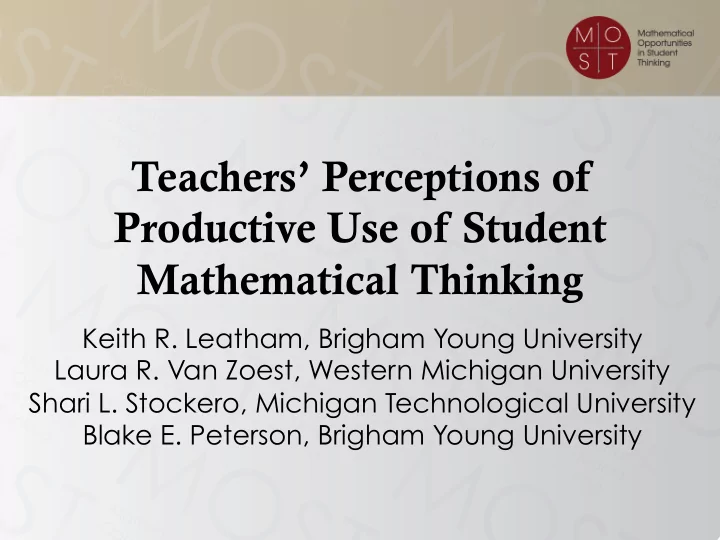

Teachers’ Perceptions of Productive Use of Student Mathematical Thinking ! Keith R. Leatham, Brigham Young University Laura R. Van Zoest, Western Michigan University Shari L. Stockero, Michigan Technological University Blake E. Peterson, Brigham Young University !
Incorporating Student Mathematical Thinking ! • The mathematics education community encourages instruction that meaningfully incorporates students’ mathematical thinking (e.g., NCTM, 2000, 2007) • The benefits of such incorporation have been documented (e.g., Fennema, et al., 1996; Stein & Lane, 1996)
Incorporating Student Mathematical Thinking ! • The mathematics education community encourages instruction that meaningfully incorporates students’ mathematical thinking (e.g., NCTM, 2000, 2007) • The benefits of such incorporation have been documented (e.g., Fennema, et al., 1996; Stein & Lane, 1996) !
What does the literature say about incorporating student mathematical thinking? ! • using student mathematical thinking (e.g., Franke & Kazemi, 2001; Peterson & Leatham, 2009) • building on student mathematical thinking (e.g., Hill, Ball, & Schilling, 2008; Van Zoest & Stockero, 2012) • attending to the mathematical thinking of others (e.g, Feiman-Nemser & Remillard, 1996; Lampert et al., 2013) • being “responsive to students and… their understanding” (Remillard, 1999, p. 331) • build on students’ prior or existing knowledge (Breyfogle & Herbel-Eisenmann, 2005; Carpenter et al., 1989) • build toward an important mathematical idea (Stein, Engle, Smith, and Hughes, 2008)
Ways Teachers Incorporate Student Mathematical Thinking ! • Use • Build on • Attend to • Be responsive to • Pursue !
Ways Teachers Incorporate Student Mathematical Thinking ! • Use • Assess whether it is ok to move on • Build on • Elicit student ideas • Attend to • Validate student • Be responsive to ideas • Pursue • Have other students ! consider the thinking • Engage in a discussion of the thinking
Research Question What are teachers’ perceptions of productive use of student mathematical thinking during whole class discussion?
Productive Use of Student Mathematical Thinking (PUMT) ! • A teacher must honor students as legitimate creators of mathematics • “Use” of student thinking must be done in the service of facilitating the learning of significant mathematics • A teacher orchestrates student learning during a lesson by doing something purposefully with student mathematical thinking that has surfaced.
Productive Use of Student Mathematical Thinking ! “engages students in making sense of mathematical ideas that have originated with students – that is, it builds on student mathematical thinking by making it the object of rich mathematical discussion” Leatham et al., 2014, p. 5
Hypothetical Learning Process for PUMT - Conjecture • Reject Active Student Participation • Value Student Participation • Value Student Mathematical Thinking • Elicit Student Mathematical Thinking • Interpret Student Mathematical Thinking • Build on Student Mathematical Thinking
Methodology – Card Sort ! Teachers were given cards that described teacher moves one might associate with classroom discourse such as: – “get students’ ideas out there for the class to consider and discuss” – “juxtapose two student ideas that differ in an important mathematical way” – “repeat an important student comment” Teachers were asked to place the cards on a continuum from least to most productive use of student thinking during whole class discussion. !
Methodology – Card Sort
Methodology • Participants – 14 mathematics teachers (6 female, 8 male) – 1 to over 20 years experience – Variety of mathematics courses taught (grades 6-12) • Interviews were video taped • Summarized each teachers perception of PUMT • Used summaries and HLP to develop coding framework • Coded 6 representative interviews
Methodology Of the coded interviews we asked the following questions: 1. What are teachers’ perceptions of productive use of student thinking? 2. To what extent do those perceptions align with the PUMT HLP?
Conjectured relationship between the PUMT HLP and various types of use PUMT HLP Type of Use Reject Active Student Participation Value Student Participation Value Student Mathematical Thinking Elicit Student Mathematical Thinking Engagement Validation Replacement Interpret Student Mathematical Thinking Assess Clarify Launch Build on Student Mathematical Thinking Pondering Establishing Extracting
Non-Use Stages • Reject Active Student Participation • Value Student Participation – “[Student should understand that] realistically, you might not use… any of these formulas in what you are going to do in life, but if you can learn to be a thinker… then that’s going to be of great benefit.” • Value Student Mathematical Thinking
Elicit • Engagement – “Trying to get the student involved is the most important thing. Everything else is secondary.” • Validation – “Acknowledging that you are thinking is important because that gives you positive reinforcement.” • Replacement
Interpret • Assess – “If they can verbalize how they are thinking about it then I actually get a better idea that they actually do know what is going on.” • Clarify • Launch – “Give them suggestions about how they could advance their thinking about the mathematics, rather than just acknowledge that they are thinking.”
Build • Pondering – A major goal in having students share their ideas is to “have the class think about them.” • Establishing – “Have the student actually write what they just said and see if… the rest of the class could apply what the other student just said to the current problem they are working on.” • Extracting – “Ask them to compare and contrast [student ideas] to try to work out how they might be related.”
Conjectured relationship between the PUMT HLP and various types of use PUMT HLP Type of Use Reject Active Student Participation Value Student Participation Value Student Mathematical Thinking Elicit Student Mathematical Thinking Engagement Validation Replacement Interpret Student Mathematical Thinking Assess Clarify Launch Build on Student Mathematical Thinking Pondering Establishing Extracting
Discussion • Is this a process—do people need to develop into a good elicitor before they become a good interpreter? • Definition of building—is this the most productive use? • Do we have this “right”? Are there other stages? Other types of use?
Recommend
More recommend